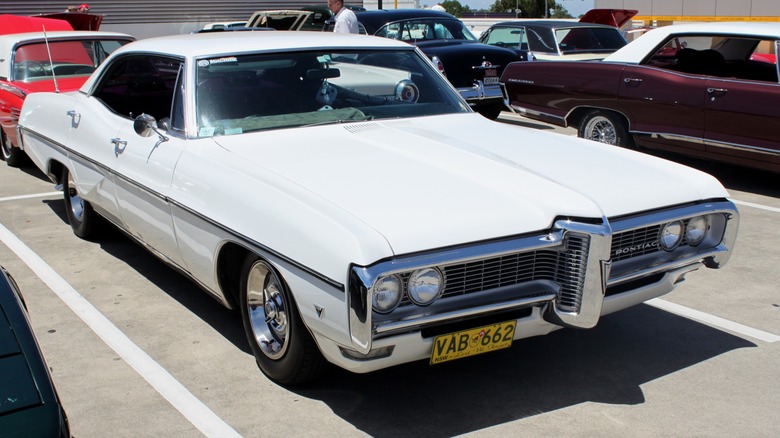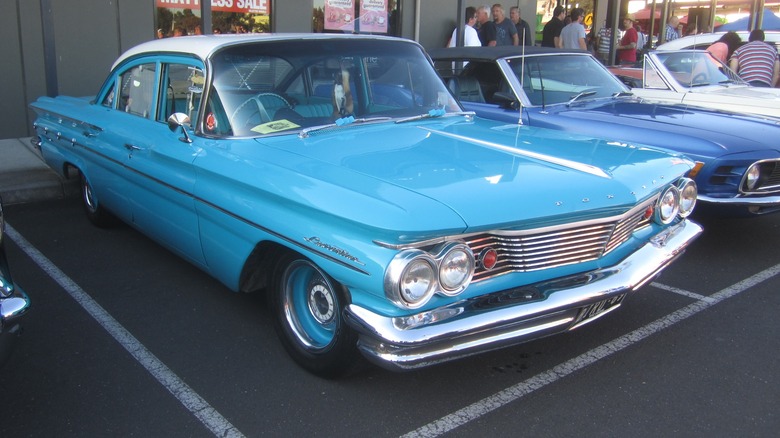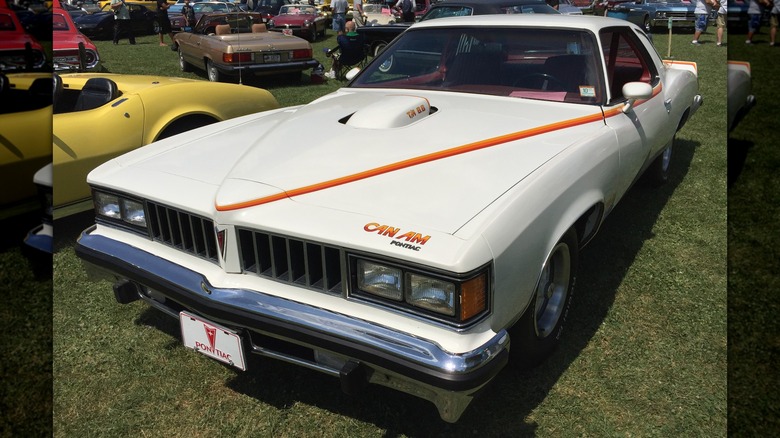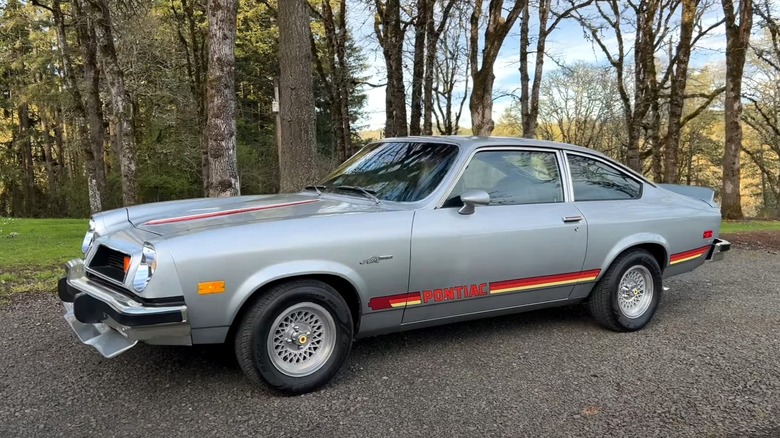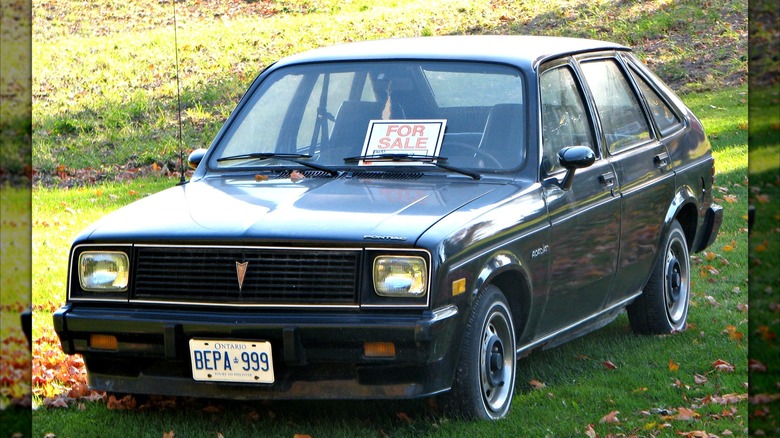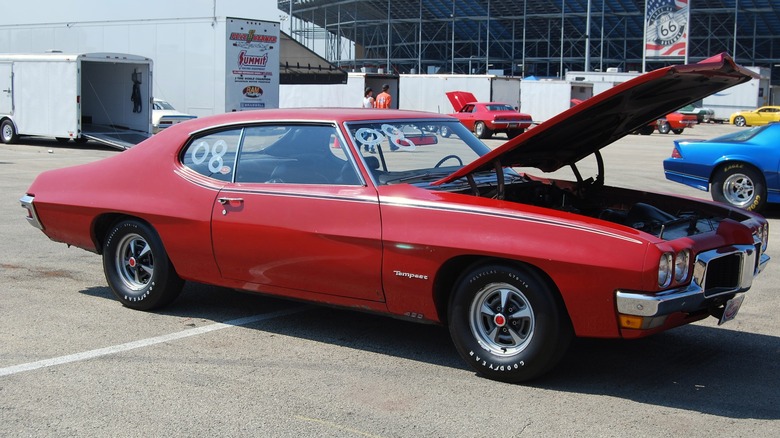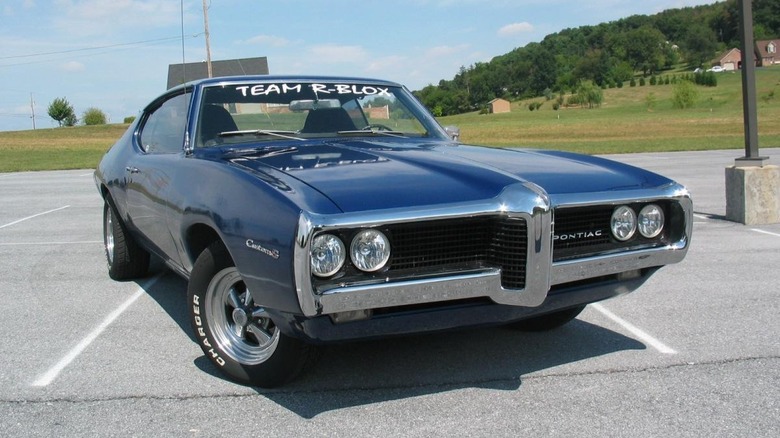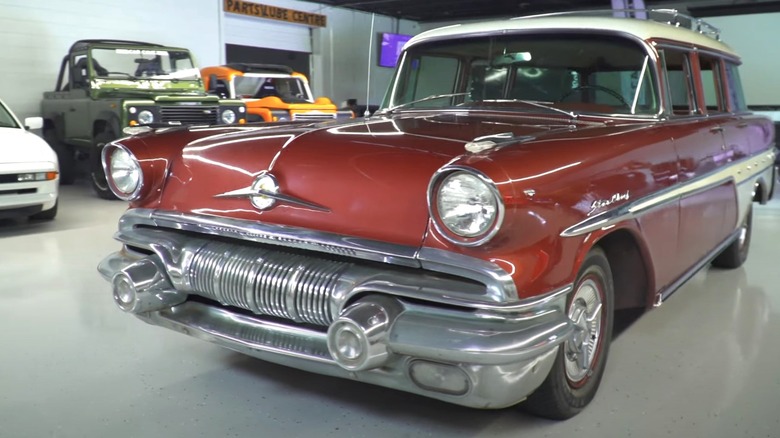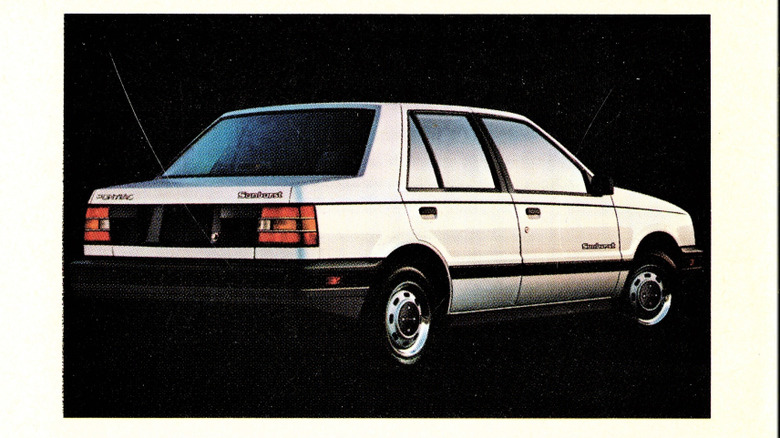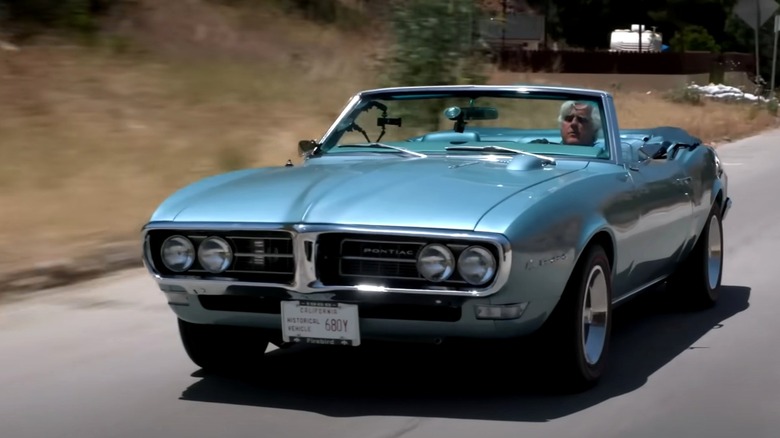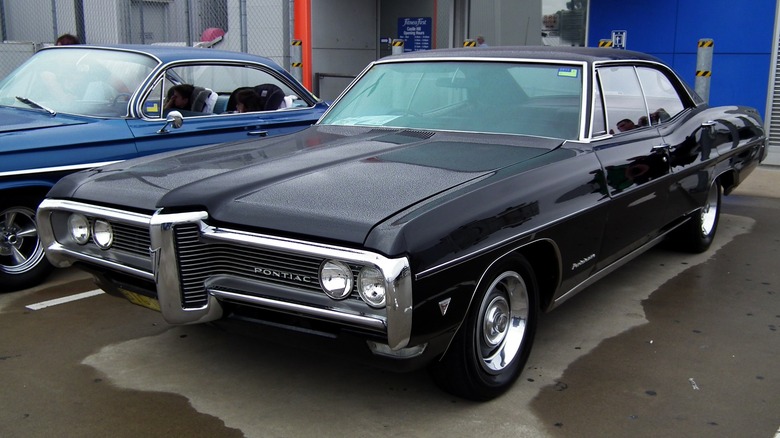10 Pontiac Models You Didn't Realize Existed
Pontiac isn't around anymore, but the name is still one of the most recognized and respected in American car culture, not least for its pivotal role in establishing the muscle car. The legendary 1964 GTO helped set the stage for a decade's worth of high-horsepower hijinks, while the brand's full-sized offerings helped establish it as one of the best-selling GM brands of the 1960s.
But while the GTO, Firebird, Grand Prix, and Bonneville are veritable household names by this point, they were far from the only cars Pontiac built over its lifespan. As with any car company, especially one as long-lived as Pontiac, more than a few models didn't quite hit the same heights as these classics. Some of these were only for international markets, and some had short production runs for one reason or another. Then there are others that... well, let's just say a few of they deserve their place on the scrap heap of automotive history.
To be clear, we're not necessarily talking about the rarest Pontiac cars, although some of these are undoubtedly hard to come by. This is all about those overlooked vehicles that every automaker has in its back catalog. Pontiac may be long dead, but its cars live on — good, bad, and sometimes ugly.
[Image by Jeremy via Wikimedia Commons | Cropped and scaled | CC BY 2.0]
Pontiac Laurentian
We kick off our list with one of the most fruitful territories for obscure Pontiacs: Canada. Despite sharing a massive land border with the U.S., many Canadian Pontiacs were unique to the country, with different nameplates compared to their American cousins. Much of this has to do with the Canadian National Policy of 1879, which taxed imports heavily to protect local Canadian manufacturing.
Canadian Pontiacs had to be locally assembled to stand any chance of winning over Canadian car buyers, and that's precisely what the Pontiac Laurentian was. However, it wasn't a totally unique car, at least as far as its constituent parts were concerned. All Canadian Pontiacs built between 1955 and 1970 were a mish-mash of GM parts, combining Chevrolet underpinnings with Pontiac-styled sheet metal.
In the Laurentian's case, GM went with the mechanicals of the Chevrolet Impala — including the 384-cubic inch V8 in 1960 — and a body styled after the U.S. Pontiac Catalina. Body styles shifted as the generations went on, adopting features like Pontiac's signature beaked front fascia and the squared-off B-body shape as its American equivalent adopted them. The main difference was the narrower track due to the Chevrolet chassis, meaning the wheels were much more tucked in than on the wide-track American Pontiacs. GM of Canada built the Laurentian from 1953 to 1981, with production ceasing alongside that of the Catalina.
[Image by Sicnag via Wikimedia Commons | Cropped and scaled | CC BY 2.0]
Pontiac Can Am
The decade from 1973 to 1983 wasn't a great time for the U.S. car industry. Rocked by tightening emissions regulations and the 1973 oil embargo, that period — commonly known as the Malaise Era, a term coined by journalist Murilee Martin — saw names like Ford release some genuinely terrible cars, all in the name of fuel efficiency and economy. Pontiac was no different: With the iconic GTO gone from the lineup after 1974, the company needed something new and era-appropriate to try and take it forward. Sadly, the 1977 Pontiac Can Am wasn't it.
The Can Am debuted in 1977 as a hopped-up performance version of the LeMans Sport Coupe birthed from the mind of Jim Wangers, Pontiac's chief marketing manager. Wangers was no stranger to special editions of cars, having been involved with Motortown Corporation — a name that'll pop up again later in this list — and cars like the Ford Mustang Cobra II. The Can Am sported a white paint job and wheels, offset brilliantly by orange-and-yellow racing stripes across the body.
The car wasn't just a pretty face, either. A 200 hp, 6.6-liter V8 took pride of place in the engine bay, while upgrades such as front disc brakes, power steering, a Rally RTS handling package, stabilizer bars, and Turbo-Hydramatic automatic transmission combined to set it apart from the LeMans. Unfortunately, production ceased after only six months, with either 1,133 or 1,377 units built, making this something of a hidden gem in the Pontiac family.
[Image by Christopher Ziemnowicz via Wikimedia Commons | Cropped and scaled | CC BY 4.0]
Pontiac Astre Lil' Wide Track
The Pontiac Astre wasn't one of GM's best moments. A Chevrolet Vega rebadge, the Astre inherited many of the Chevy's problems — most notably its general unreliability — and only spent about five years in production, the first two of which were Canada-only. GM brought the Astre to the U.S. in 1975, where it sold poorly compared to the Vega, with only 64,000 units selling that year compared to the Vega's 174,000.
So, it's already something of a forgotten Pontiac, at least for the average car fan. But there was an even more obscure version of the Astre: the charmingly named Astre Lil' Wide Track from 1975. The brainchild of Motorown Corporation, the Lil' Wide Track was a one-year-only visual package for the Astre that made it look a bit more exciting but sadly did nothing to alter the car's performance.
Buyers got aluminum wire wheels, some go-faster stripes, a "functionally styled" front air dam, and an integrated rear spoiler, all in a cool gray finish. It looked good — in a mid-1970s way, of course — but was still a plain Astre underneath all the fancy dress. Motortown allegedly built around 3,000 Astre Lil' Wide Tracks, with reportedly only a very handful surviving to this day. One popped up on Bring a Trailer earlier in 2024 but failed to sell — and if something this rare doesn't sell, you know it's probably not all that great a car.
Pontiac Acadian/T-1000
The Pontiac Laurentian may not have been entirely original, but it was at least more than just a rebadged Chevrolet. If you want to talk about pure GM badge engineering, you have to turn to Pontiacs like Astre and its even more compact sibling, the Acadian. Both of these were rebadged Chevrolets, with the Acadian being a Pontiac-branded Chevrolet Chevette — itself technically an import, given its German origins — marketed specifically to those in the Great White North.
This wasn't the first time GM used the Acadian name in conjunction with its Canadian efforts — it also used it for the Canadian version of the Chevrolet Nova, which it built from 1962 to 1971. The name lay dormant for a few years before GM revived it by launching the Pontiac Acadian. The new Acadian, which debuted in 1976, was just like any badge-engineered car: It inherited the Chevette's strengths — such as rear-wheel drive — and weaknesses, namely a relatively weedy engine that made less than 60 hp.
GM renamed the Acadian to the T-1000 in 1981, at which point the car was making a heady 65 hp. The name change coincided with its debut in the U.S. market, where GM sold it alongside the identical Chevrolet Chevette. Things didn't go well for the Pontiac, with the Chevette outselling it by a significant margin. In 1981, for example, GM moved 420,448 Chevettes compared to just 70,194 T-1000s. GM pulled the plug on the Chevette in 1987, and the Acadian/T-1000 went along with it.
[Image by Michael via Wikimedia Commons | Cropped and scaled | CC BY 2.0]
Pontiac GT-37
The Pontiac GT-37 isn't quite as unknown as many of the others on this list, but this two-year-only version of the T-37 still ranks as one of the most under-appreciated Pontiac muscle cars of the 1970s. The GT-37 was essentially a T-37 with some visual mods, which in itself began as a variant of the Tempest in 1970 — before replacing the Tempest completely in 1971.
The Tempest and T-37 were budget offerings, but they weren't slouches. 1970 Tempest buyers could opt for the 345-hp, 400-cubic inch Ram Air III engine, which would have been a big upgrade over the standard 155-hp inline-six. But Pontiac didn't just offer a selection of engines: V8 T-37 buyers could also upgrade to the GT-37 package, which added the GTO's dual exhaust system, special graphics, white-letter tires, hood pins, and fancy racing stripes. The GT-37 package also added a new three-speed transmission. Despite falling under cheaper Tempest insurance rates, the GT-37 wasn't particularly popular in 1970; only 1,419 left the factory in 1970.
Pontiac continued offering the GT-37 in 1971, albeit with minor design tweaks such as new side stripes. 1971 also saw Pontiac offering a new engine in the (G)T-37, namely the 455-cubic inch high-output V8. This 455 made 335 hp and 480 lb-ft of torque, which propelled the 1971 GT-37 down the quarter mile quicker than a GTO Judge. Despite that, Pontiac only sold 5,802 GT-37s, just over half of the 10,532 GTOs it sold that year.
[Image by artistmac via Flickr | Cropped and scaled | CC BY-SA 2.0]
Pontiac Custom S
As rare as it was, the 1970 and 1971 GT-37 wasn't the only obscure Tempest-related model that Pontiac offered around the turn of the decade. There was also the Custom S, a one-year-only A-body Pontiac that slotted in between the affordable Tempest and the more well-equipped LeMans for the 1969 model year.
The Custom S replaced the Tempest Custom, which had been a trim level for the Tempest since its debut in 1961. The Custom was a slightly upmarket version of the Tempest, with creature comforts like an all-Morrokide interior and a convertible body style not available for the base Tempest. A 175-hp, 250-cubic inch inline-six came standard, much like the base Tempest. Those who wanted a bit more visual excitement could opt for the Tempest Custom Sprint, which added a hotter 215-hp inline-six and some GTO-esque styling.
Pontiac didn't change its stance much when it introduced the Custom S in 1969. It was still the cheapest way to get a convertible Tempest, still came with the 175-hp inline-six as standard, and continued to top out at the 300 hp-plus high-output 350-cubic inch V8, albeit with 330 hp for 1969. Essentially identical to the old Tempest Custom, then, but that's precisely why you may not know that it ever existed: Pontiac could have continued calling it the Tempest Custom, and nobody would have batted an eyelid. But it added that "S," and earned this trim level a place in history — in a way.
Pontiac Star Chief Custom Safari Transcontinental
This particular rare Pontiac hails from the pre-muscle car era, when chrome and curves were the order of the day. It also has the most extravagant name of the bunch: Say hello to the short-lived Pontiac Star Chief Custom Safari Transcontinental.
Unless you're well-versed in Pontiac nomenclature, the name will need some explaining. The easiest and most familiar is likely Safari, which Pontiac started using in 1957 to refer to its station wagon models, and would continue to use over the next few decades. The Star Chief was Pontiac's highest-end offering in the late 1950s, with "off-the-shoulder" upholstery mimicking the look of a single-strap dress and a 270-hp V8 under the hood, all wrapped up in one of the coolest-looking body styles the company ever produced. Finally, Transcontinental indicates four doors. So altogether, this was a high-spec, four-door station wagon with all of GM's late-'50s trimmings.
Pontiac introduced the Star Chief Custom Safari Transcontinental as a mid-year model in 1957 alongside the then-new Bonneville. As you might expect for such a specific combination of body style and trim level, the Star Chief Custom Safari Transcontinental didn't sell well, with only 1,894 Star Chief Custom Safari Transcontinentals making their way to customers. Not that the two-door version did any better — Pontiac only sold 1,296 two-door wagons, making both Star Chief wagons two of the more collectible Pontiacs out there.
Pontiac Sunburst
GM has never been afraid to indulge in a bit of badge engineering, whether it involves sourcing vehicles from overseas — such as the Toyota-based mid-'80s Chevrolet Nova — or rebadging its cars for different markets, like the Astre and Acadian. But this particular car raises the game over all those by doing both — and most of you will probably have never heard of it.
The Sunburst is possibly the most forgotten Pontiac model ever. Yes, that sounds like hyperbole, but try searching for it on your engine of choice. You'll probably get more results for the Pontiac Sunbird and Sunfire, two similarly named but radically different cars. That because, for far as forgettable Pontiac badge engineering exercises go, the Sunburst probably takes the cake.
GM was already selling rebadged Isuzu Geminis as the Chevrolet — and later Geo — Spectrum in the U.S., competing directly with Isuzu, who sold it as the I-Mark. But GM rebadged the car again for Canadians, slapping a Pontiac badge on the front and calling it the Sunburst. As ever, the Sunburst was the same car as the Spectrum, dull 70-hp engine in tow. Given that GM sold an identical vehicle in the U.S., there's no real reason for those outside of Canada to be aware of the Sunburst. Combine that with how short-lived these Gemini-based GMs were, and you have the recipe for one truly forgotten Pontiac.
[Image by Alden Jewell via Flickr | Cropped and scaled | CC BY 2.0]
Pontiac Firebird Sprint
The Pontiac Firebird itself isn't rare, forgotten, or obscure. It's probably one of the best-known Pontiacs ever, with a 35-year production run that encompassed a handful of iconic body styles and many iconic engines. But amongst all the Firebird Formulas and Trans Ams lies an interesting footnote from 1968.
The Firebird Sprint was Pontiac's attempt to inject a bit of European flair into its muscle car lineup, with promotional material highlighting European-style features like a firm suspension, floor-mounted three-speed transmission, wide-oval tires, and heavy-duty clutch. But the most drastic difference was the engine: Despite coming out smack dab in the middle of the golden age of the muscle car, the Firebird Sprint convertible didn't have a big, hulking V8 under the hood. Instead, the Sprint was a six-cylinder car, sporting the same 250 cubic inch inline-six as base Firebirds, but with upgrades such as an overhead cam, four-barrel carb, and racier camshaft bringing power up to 215 hp.
Unfortunately, the Sprint's European aspirations were perhaps slightly misguided. Not because the car itself was bad, though. Instead, the main problem for the Firebird Sprint was that it made less power than a contemporary V8 Firebird — even the lowly Firebird 350 had 265 hp on tap — but actually cost more. Consequently, Pontiac only sold 7,459 Sprints, a drop in the ocean compared to the 58,278 Firebird 350s that left the factory that year.
Pontiac Parisienne
We end where we began, discussing a full-size Canadian Pontiac model that combines a Chevrolet drivetrain and chassis with a U.S. Pontiac-derived body. The Pontiac Parisienne debuted as a trim level of the Laurentian in 1958, before becoming a standalone model in 1959.
Just like the Laurentian was a Canadian take on an American model, the Parisienne was also a version of a U.S. Pontiac, namely the Bonneville. It sat at the top of GM's full-size line in Canada and, like its sibling, ran with Chevrolet hardware underneath the sheet metal. Engine options mirrored those in contemporary Chevrolets: 1960s Parisiennes topped out at a 280 hp 348 cubic inch V8, but GM started offering a 425 hp, 409 cubic inch V8 by 1963.
The Parisienne was longer-lived than the Laurentian, surviving into 1986 — albeit with a major change for its final few years. In 1982, GM decided to downsize its Pontiac offerings, turning the seventh-generation Pontiac Bonneville into the mid-sized Bonneville Model G. Unfortunately, this wasn't an option for the Canadian market, which loved its cheap, full-size Pontiacs. To fill this gap, GM rebadged and tweaked the Canadian-built Chevrolet Caprice and launched a new full-size Parisienne in 1982. This version then ended up for sale in U.S. starting in 1983, allegedly at the behest of dealers who needed a full-sized Pontiac to sell. The Parisienne was thus available in both the U.S. and Canada for its final few years before GM discontinued it after 1986.
[Image by sv1ambo via Flickr | Cropped and scaled | CC BY 2.0]
